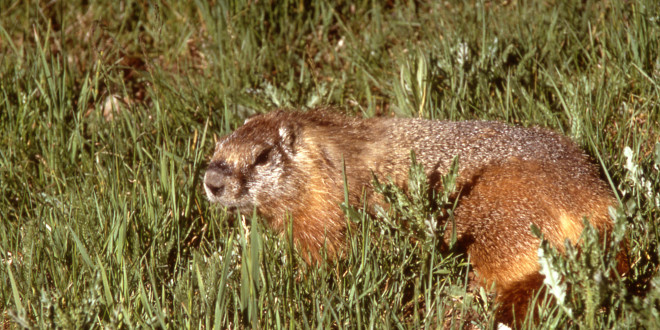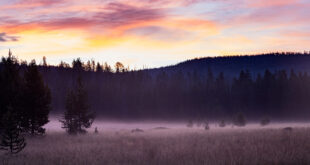The yellow-bellied marmot is a treat to see, as delightful to see as a wolf or a bison or a bear in Yellowstone National Park.
This is not hyperbole. Marmots are great little creatures to see: sunning themselves on rocks, scurrying around the hillsides near geysers. It’s true they don’t have the presence of bison or the stockiness of grizzly bears, but they possess a cute charisma.
They’re also surprisingly photogenic, although (as with any wildlife) don’t get too close.
Yellow-bellied marmots are widely dispersed in Yellowstone National Park—as well as most of Western North America, including the Sierra Nevada—and prefer landscapes with lots of thick grass and rocks.
And in spite of what the video below suggests, yellow-bellied marmots are not accompanied by quick and lively piano music wherever they go.
Basic Facts
- Scientific name: Marmota flaviventris
- Size: 20-28 inches in length.
- Weigh 3.5-11 pounds.
- Males are larger than females.
- Can live for up to 13-15 years.
- Named for the yellow fur on their belly.
- Body is otherwise reddish-brown.
- Marmots have small ears and an active tail.
- Most commonly found in morning, late afternoon, and evening.
Habitat
- Prefer grasslands and large rocks.
- Found in valleys and alpine areas alike.
- Yellow-bellied marmot colonies consist of one male and several females, plus yearlings.
Behavior
- Males are territorial of their burrows.
- They demonstrate dominance by waving their tail back and forth menacingly and leaving scent around.
- Friendly yellow-bellied marmot behavior includes grooming and playing.
Diet
- Forage for grasses and forbs for most of the summer.
- Will eat seeds in late summer, as well as the occasional insect.
- Serve as prey for coyotes, grizzly bears, and golden eagles.
Hibernation
- Yellow-bellied marmots hibernate for up to eight months.
- Depending on what elevation their colony is found at, marmots may emerge from hibernation as early as February or as late as May.
- Have been known to estivate (temporarily hibernate) in June if the climate is dry.
Reproduction
- Begin mating two weeks after hibernation ends.
- An average of five young per couple are born each year.
- Only half a litter tends to survive the first year.
Whistle Pig
- Yellow-bellied marmots are renown for their whistling; they are the source of the term “whistle pig.”
- Marmots generally whistle, although they can also “chuck.”
- Marmots make a trilling noise when scared.
- The general purpose of whistling is in response to predators.
 Yellowstone Insider Your Complete Guide to America's First National Park
Yellowstone Insider Your Complete Guide to America's First National Park





